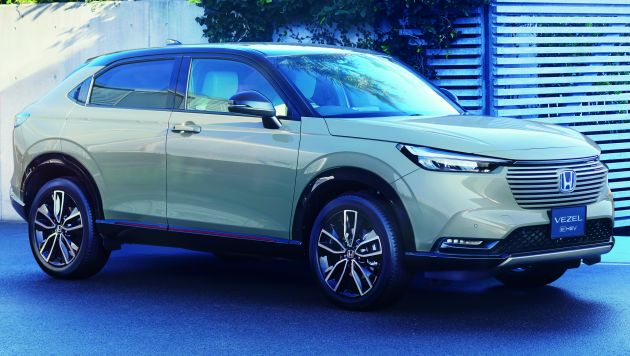2022 Honda HR-V launched in Japan – 131 PS/253 Nm e:HEV, 118 PS/142 Nm 1.5L NA i-VTEC, from RM87k
Revealed to the world in February, the new third-generation Honda HR-V has just been launched in its home market in Japan, where it retains the Vezel name. Sales kick off tomorrow, with the hugely popular B-segment SUV being offered in both regular petrol and e:HEV dual-motor hybrid variants.
The former utilises an L15Z 1.5 litre naturally-aspirated i-VTEC engine from the outgoing Indonesian model but now with double overhead cams. It’s actually quite a bit less powerful than the old Vezel – shorn of direct injection, it makes 118 PS (-14 PS) at 6,600 rpm and 142 Nm (-13 Nm) of torque at 4,300 rpm. A CVT continues to be standard fare, with shorter ratios compared to the Jazz to compensate for the extra weight.
As for the e:HEV, the electric motor is more powerful than the Jazz’s and City’s, producing 22 PS more at 131 PS (identical to the Insight, incidentally) but the same 253 Nm. The Atkinson-cycle 1.5 litre mill that juices the motor has also been beefed up and now makes 106 PS (up 8 PS); torque again holds station at 127 Nm.
Supporting the more powerful motor is a larger Intelligent Power Unit (IPU) lithium-ion battery, which now features 60 cells instead of 48, thanks to the repositioning of the Power Control Unit (PCU) in the engine bay. Honda is claiming fuel consumption figures of up to 17 km per litre for the petrol model and 25 km per litre for the e:HEV. Both variants come with all-wheel drive as an option, as is typical in Japan.
As previously reported, the HR-V sports a cleaner design, with a heavily-raked rear windscreen giving the car a more coupé-like aesthetic. Riding on the same platform as the latest Jazz and City, the new car is ever so slightly shorter (1,330 mm) but 20 mm wider (1,790 mm) and lower (1,590 mm), contributing to its low-slung look. Honda has also improved outward visibility by pushing the A-pillars rearward, straightening the window line and placing the door mirrors on stalks on the door skin.
To improve aerodynamics, Honda has sought help from its research and development facility in Sakura, the same one that develops the engines for Red Bull Racing and Scuderia Alpha Tauri in Formula 1. The HR-V now benefits from air curtains in the front bumper, outward-turning side skirts, a new rear spoiler design and reshaped taillights to deliver greater efficiency.
Inside, the HR-V gets a minimalist horizontal dashboard that incorporates a freestanding infotainment touchscreen and full-width air vents. The L-shaped corner vents diffuse airflow from the air-conditioning by directing it along the windscreen and side windows to the roof, improving passenger comfort – as do the new rear vents. There’s also a larger panoramic glass roof that is larger than before and uses special Low-E glass to minimise infrared and ultraviolet light penetration. It no longer opens, however.
Despite the same 2,610 mm wheelbase as before, Honda’s “Man-Maximum, Machine-Minimum” philosophy has somehow managed to free up an extra 35 mm of rear legroom. Not only that, but the rear seats have also been reclined by a further two degrees for increased seating comfort. Other neat features include sliding front sun visors, touch-controlled map lights and a hands-free powered tailgate.
In terms of tech, the HR-V is offered in Japan with Honda Connect, which consists of a nine-inch infotainment system and a range of connectivity services under the Honda Total Care Premium banner. These include a Honda-first in-car WiFi hotspot, an app centre, automatic map updates, a smartphone digital key and vehicle-to-infrastructure (V2I) connectivity that allows the car to tell you if you can make the green light in front. Also available is a seven-inch instrument display on e:HEV models an a ten-speaker sound system.
The HR-V also comes as standard in Japan with the full range of Honda Sensing driver assists, including autonomous emergency braking (now with pedestrian and cyclist detection and evasive steering assist), adaptive cruise control with stop and go, lane centring assist, lane keeping assist, blind spot monitoring, auto high beam, front departure alert and pedal misapplication control which also works in reverse. Honda has also added hill descent control for the first time on a domestic model.
Under the skin, the HR-V has been given several ride and handling upgrades, starting with an ultra-stiff and lightweight body. The retuned suspension and revised bushings have improved comfort by removing unwanted movements, while lower-friction suspension components and a stiffer steering column make for a more dynamic steer. A new engine mount structure and measures to reduce noise at certain frequencies have also suppressed fluctuations in engine noise, Honda says.
Prices for the HR-V start from 2,279,200 yen (RM86,600) for the base petrol G, rising up to 2,658,700 yen (RM101,000) for the entry-level e:HEV X hybrid. The mid-range e:HEV Z retails at 2,898,500 yen (RM110,100), while the range-topping e:HEV PLaY costs 3,298,900 yen (RM125,300).














































































































The post 2022 Honda HR-V launched in Japan – 131 PS/253 Nm e:HEV, 118 PS/142 Nm 1.5L NA i-VTEC, from RM87k appeared first on Paul Tan's Automotive News.
from Paul Tan's Automotive News
Read The Rest:paultan...






Post a Comment